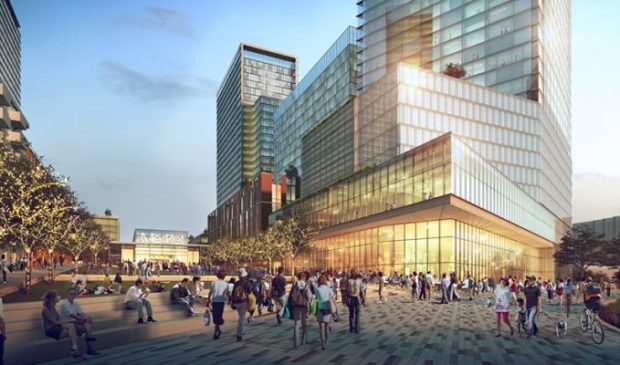Will Merck IT hub anchor Central Health redevelopment?
Friday, July 28, 2017 by
Chad Swiatecki This much is clear: Pretty much everyone agrees that the redevelopment of the University Medical Center Brackenridge campus is going to redefine the eastern edge of downtown Austin in the coming years.
What is much less clear is what, exactly, will rise over the course of the next 12 to 15 years on the 14 acres that sit within the area local leaders have designated a “health care innovation zone.”
The future of the high-profile tract will be clearer this fall when officials with Central Health, the area health care nonprofit that owns the land, selects a master developer from the three groups still in the running to bring new life to the area. A selection is expected to be made in early October, according to the request for proposal documents for the project, but Central Health’s executive in charge of real estate said the decision may be delayed if the evaluation process takes longer than anticipated.
Proposals for the project are due Aug. 25. Deliberations on the proposals will happen with life sciences giant Merck Sharp & Dohme eyeing real estate in Austin for its first wave of employees to set up an information technology center that is expected to cost $28 million.
“We’re hoping for very creative solutions for how to utilize the property, and (developers’) ideas will influence things along with what the market demand is, so we don’t know what the first building could be,” said Steven Lamp, vice president of real estate and facilities for Central Health. “Merck coming into this area could do a build-to-suit deal and that would be a big part of it. The location and the overall guidelines for the project may contribute to additional health care interests in the location.”
Lamp said he and other Central Health officials have had no contact with Merck about the redevelopment providing a possible site for its Austin hub, but he said the company would be a “natural anchor” there.
The request for proposal for the site includes language recommending a health care focus, some affordable housing units and a public market featuring a food hall, health innovation center, food culture center and public spaces.
The master plan for the two-phase project estimates it will have 3.7 million square feet of office, medical, residential, commercial and retail space available. Central Health’s revenue share from the development of the property is expected to be a major component of its budget in the future, making its financial success important for the nonprofit that provides health care services for much of the Austin area’s vulnerable communities.
That places a large responsibility on Lamp, who joined Central Health four months ago and has managed more than $2.5 billion in real estate projects on five continents over his 30-year career.
“Central Health’s mission is health care for the community and the master plan was comprehensive in laying out the pieces on things like affordable housing and health that will be included,” he said. “If we partner with (the University of Texas) to make it an educational locus it might also offer opportunities for (Austin Community College) to offer medical IT degrees there. It’s a balancing act between lots of different forces.”
The city of Austin’s role in the immediate future of the project is minimal through the end of the year, but Lamp said talks will soon begin on the final configuration of Red River Street near the property, a rezoning request for the property and possible negotiations on the density allowed there. A majority of the property is expected to be ready for demolition by May 2018, with existing parking and some complementary buildings slated to remain until 2024.
Asked about the potential of the project and the larger innovation zone compared to existing health care hubs in Massachusetts and California, Lamp said Central Health’s goal in its developer selection is to attract a mix of businesses that fit with what’s happening nearby at the Dell Medical School and Seton Healthcare Family’s new teaching hospital.
“A place like Silicon Valley happens because there’s a critical mass of people, and an area gets a reputation for having a certain thing and it’s where you want to go if that’s your thing,” he said. “We’re not trying to pack people in like Chicago or downtown Manhattan, and we need long-term flexibility because this property might be redeveloped three or four times over the next 99 years, but creating that critical mass and seeing some activity soon is important.”
Conceptual illustration from the Brackenridge Campus Master Plan courtesy of Central Health.
The Austin Monitor’s work is made possible by donations from the community. Though our reporting covers donors from time to time, we are careful to keep business and editorial efforts separate while maintaining transparency. A complete list of donors is available here, and our code of ethics is explained here.
You're a community leader
And we’re honored you look to us for serious, in-depth news. You know a strong community needs local and dedicated watchdog reporting. We’re here for you and that won’t change. Now will you take the powerful next step and support our nonprofit news organization?










